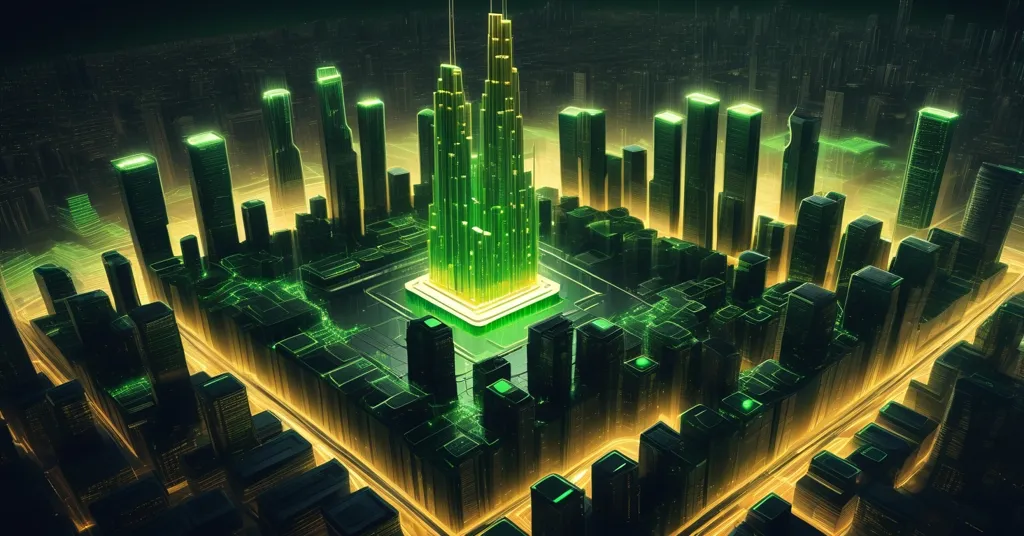Nvidia Stock Soars to $4.89T: Boon or Bane for Bitcoin Mining?

Nvidia’s Stock Rockets 5% to $4.89 Trillion: A Double-Edged Sword for Bitcoin and Blockchain
Nvidia’s stock surged 5% to a record high on Tuesday, catapulting its market valuation to a mind-boggling $4.89 trillion, just a hair shy of the $5 trillion mark. With blockbuster reveals at its GTC event, from AI breakthroughs to massive partnerships, Nvidia isn’t just leading the tech charge—it’s also a linchpin for cryptocurrency mining and blockchain innovation. But is this tech titan a true ally for decentralization, or a corporate juggernaut that could leave crypto in the dust?
- Stock Surge: Nvidia’s 5% jump pushes valuation to $4.89 trillion, fueled by GTC announcements.
- Tech Dominance: New AI chips, supercomputers, and 6G partnerships cement Nvidia’s lead.
- Crypto Impact: Vital GPU hardware for Bitcoin mining faces risks from supply issues and corporate priorities.
Nvidia’s Tech Boom: What’s Driving the Hype?
The recent spike in Nvidia’s stock isn’t some random Wall Street whim—it’s the direct result of a string of jaw-dropping announcements at the company’s GTC event. Having already smashed through the $4 trillion valuation barrier in July, Nvidia is now gunning for $5 trillion, solidifying its status as a semiconductor behemoth with a valuation of $4.89 trillion after a 5% stock increase. Leading the charge is CEO Jensen Huang, who unveiled a slew of innovations and partnerships that have investors salivating over the future of artificial intelligence (AI), data centers, and beyond.
Topping the list is a collaboration with the U.S. Department of Energy to build seven supercomputers, including a monster powered by 10,000 Blackwell GPUs. For the uninitiated, GPUs—or graphics processing units—are specialized chips that handle massive computational tasks, from rendering video game graphics to crunching numbers for Bitcoin mining. The Blackwell chips are Nvidia’s latest brainchild, optimized for the insane demands of AI training and big data processing. Beyond government projects, Nvidia is teaming up with Uber to push autonomous vehicle tech, selling 1,000 GPUs to pharma giant Eli Lilly, and partnering with Nokia to develop 6G communications—a next-gen wireless standard that could enable lightning-fast, ultra-secure data transfers for decentralized networks.
That’s not all. Nvidia’s tentacles stretch across industries with alliances alongside Oracle, Palantir, Cisco, and T-Mobile to boost AI infrastructure and national security tech. Its AI systems are also driving robotics for giants like Amazon, Foxconn, Caterpillar, and Belden. On the bleeding edge, Nvidia introduced NVQLink, an open architecture for quantum supercomputer innovation with partners like Rigetti and IonQ. If quantum computing sounds like something out of a sci-fi flick, think of it as a potential game-changer—offering processing power so immense it could crack current cryptographic systems or solve blockchain scalability woes in ways we can barely fathom today.
Financially, Nvidia isn’t messing around. Huang projected over $500 billion in revenue by 2026, driven by Blackwell chips and the upcoming Rubin platform. Strategic investments are also piling up: $5 billion in Intel (once a bitter rival), $100 billion in OpenAI, $500 million in self-driving startup Wayve, and $667 million in U.K. cloud provider Nscale. These aren’t just cash grabs—they’re calculated moves to anchor Nvidia at the heart of every tech trend, with potential ripple effects for blockchain and decentralized systems.
Crypto’s Stake in Nvidia’s Game: Backbone of Bitcoin Mining
For anyone in the Bitcoin and blockchain space, Nvidia’s name is practically synonymous with mining hardware. GPUs are the lifeblood of proof-of-work (PoW) cryptocurrencies like Bitcoin, powering the intense calculations needed to validate transactions and secure the network. Back in the 2017-2018 Bitcoin bull run, Nvidia GPUs were sold out everywhere, with miners scrambling to build rigs during the price frenzy. Even as Ethereum shifted to proof-of-stake in 2022, slashing GPU demand for its network, countless altcoins and smaller PoW projects still rely on Nvidia’s hardware to keep chugging along.
But Nvidia’s latest moves beg a critical question: will the crypto community continue to benefit from this tech titan’s innovations, or get sidelined by glossier boardroom priorities? On the optimistic side, advancements in AI and quantum computing could indirectly revolutionize blockchain. Picture AI optimizing smart contracts on platforms like Ethereum, cutting gas fees, or enhancing DeFi protocols with predictive analytics. Quantum computing might one day solve scalability bottlenecks, enabling thousands of transactions per second on decentralized ledgers. These are speculative leaps, sure, but they’re within the realm of possibility given Nvidia’s R&D muscle.
Yet, there’s a darker side. As Nvidia pivots hard toward AI and enterprise markets—where margins are fatter and clients are corporate whales—miners could get the short end of the stick. GPU prices have historically spiked during high demand, and with AI data centers gobbling up supply, hobbyist Bitcoin miners might find themselves priced out entirely. Industrial-scale mining operations, backed by deep pockets, could weather the storm, but the little guy running a rig in their garage? Good luck. And let’s not pretend Nvidia’s crying over crypto’s niche needs when they’ve got billion-dollar deals with Amazon and the U.S. government on the table.
Geopolitical Wildcards: Supply Risks for Miners
Nvidia’s story isn’t just about tech—it’s tangled up in messy geopolitics that could hit crypto miners where it hurts. The company is currently locked out of the massive Chinese market due to U.S. trade restrictions, a blow considering China’s vast pool of AI developers and potential revenue. Jensen Huang isn’t mincing words on the issue, pushing hard for access with a stark warning:
“We want to compete against China, no doubt about that. We want America to win this AI race, no doubt about that … But we also need to be in China to win their developers. A policy that causes America to lose half of the world’s AI developers is not beneficial in the long term.”
With trade talks looming between U.S. President Donald Trump and Chinese President Xi Jinping, there’s buzz of a deal that might let Nvidia resume chip sales in China, possibly with the U.S. taking a 15% cut of the revenue. U.S. Energy Secretary Chris Wright offered a hopeful take:
“I feel quite optimistic that we will have an agreement and arrangement coming out of that will benefit the United States and benefit the world.”
But here’s the rub for crypto: any hiccup in these negotiations—or worse, tighter export bans—could throttle GPU supply chains. Remember the Huawei debacle, where U.S. sanctions kneecapped a tech giant overnight? A similar move on Nvidia’s chips could mean shortages or skyrocketing tariffs, directly jacking up costs for miners worldwide. Bitcoin’s security relies on decentralized mining power, and if hardware becomes scarce or unaffordable, centralization risks creep in—hardly the vision Satoshi had in mind.
Competition and Market Dynamics: Alternatives on the Horizon?
Nvidia’s not operating in a vacuum—competition is heating up, and it might just give miners some breathing room. AMD is making waves, securing deals to supply up to 6 gigawatts of AI processors to OpenAI and 50,000 GPUs to Oracle. Qualcomm is also stepping into the AI data center ring with new accelerator chips. While Nvidia’s lead in GPU tech is undeniable, these rivals could disrupt its near-monopoly in high-performance computing.
For the crypto crowd, this could be a mixed blessing. If AMD or Qualcomm start offering comparable hardware at lower prices, miners might have viable alternatives to Nvidia’s often eye-watering costs. On the flip side, if competitors focus on AI and enterprise just like Nvidia, the crypto niche could remain a low-priority afterthought across the board. And let’s be real: none of these companies are exactly champions of decentralization—they’re corporate beasts chasing profit, not ideology.
Future Watch: Risks and Opportunities for Decentralized Tech
Looking ahead, Nvidia’s trajectory is a double-edged sword for Bitcoin and blockchain enthusiasts. On one hand, their push into AI could birth tools that enhance decentralized systems—think AI-driven consensus mechanisms that make networks more efficient or predictive models that stabilize volatile DeFi markets. Quantum computing, while still years away from practical use, might one day tackle cryptographic challenges, potentially securing blockchain against future threats or, conversely, breaking current encryption if not countered with quantum-resistant tech.
But here’s the devil’s advocate take: does Nvidia’s corporate dominance align with the rebellious, anti-status-quo spirit of crypto? Hardly. A handful of tech giants controlling AI and quantum advancements risks centralizing power even further—ironic for a community hell-bent on decentralization. If Nvidia’s innovations cater to sanitized enterprise needs over gritty, disruptive tech like Bitcoin, we might see a future where miners and developers are forced to play by corporate rules or get left behind. Will this tech revolution empower the underdog, or just fatten the wallets of boardroom suits?
Key Questions and Takeaways for Crypto Enthusiasts
- What sparked Nvidia’s stock surge to $4.89 trillion?
A 5% increase followed major reveals at the GTC event, including Blackwell GPUs, supercomputer projects with the U.S. Department of Energy, and partnerships in AI and 6G tech. - Why are Nvidia GPUs critical for Bitcoin and cryptocurrency mining?
GPUs power the intensive calculations needed for proof-of-work mining, securing networks like Bitcoin and various altcoins by validating transactions. - How could Nvidia’s focus on AI impact crypto miners?
A shift toward AI and enterprise markets might drive GPU prices up or reduce availability, potentially pricing out smaller miners while favoring large-scale operations. - What risks do U.S.-China trade tensions pose for blockchain hardware?
Restrictions or failed trade deals could disrupt GPU supply chains, leading to shortages or higher costs that hurt miners and risk centralizing mining power. - Could competition from AMD and Qualcomm benefit the crypto space?
Possibly—their entry into high-performance computing might offer miners cheaper or alternative hardware, though their corporate focus may still sideline crypto needs. - Should Bitcoin maximalists worry about Nvidia’s corporate trajectory?
Yes, while Nvidia’s hardware underpins Bitcoin’s security, its enterprise priorities could clash with decentralization’s ethos, potentially neglecting the crypto community’s unique demands.
Nvidia’s meteoric rise to a $4.89 trillion valuation is a testament to its raw power in shaping technology’s future, from AI to quantum computing. For Bitcoin maximalists and blockchain advocates, the company remains a vital cog in the decentralized machine, powering the mining rigs that secure our networks. Yet, as Nvidia chases corporate glory and navigates geopolitical minefields, the crypto world must brace for turbulence—higher costs, supply crunches, or a slow drift away from our disruptive roots. This isn’t just a tech story; it’s a test of whether the gears of innovation will grind toward freedom or fortify the status quo. Keep your eyes peeled—crypto’s got to adapt or risk being steamrolled.



